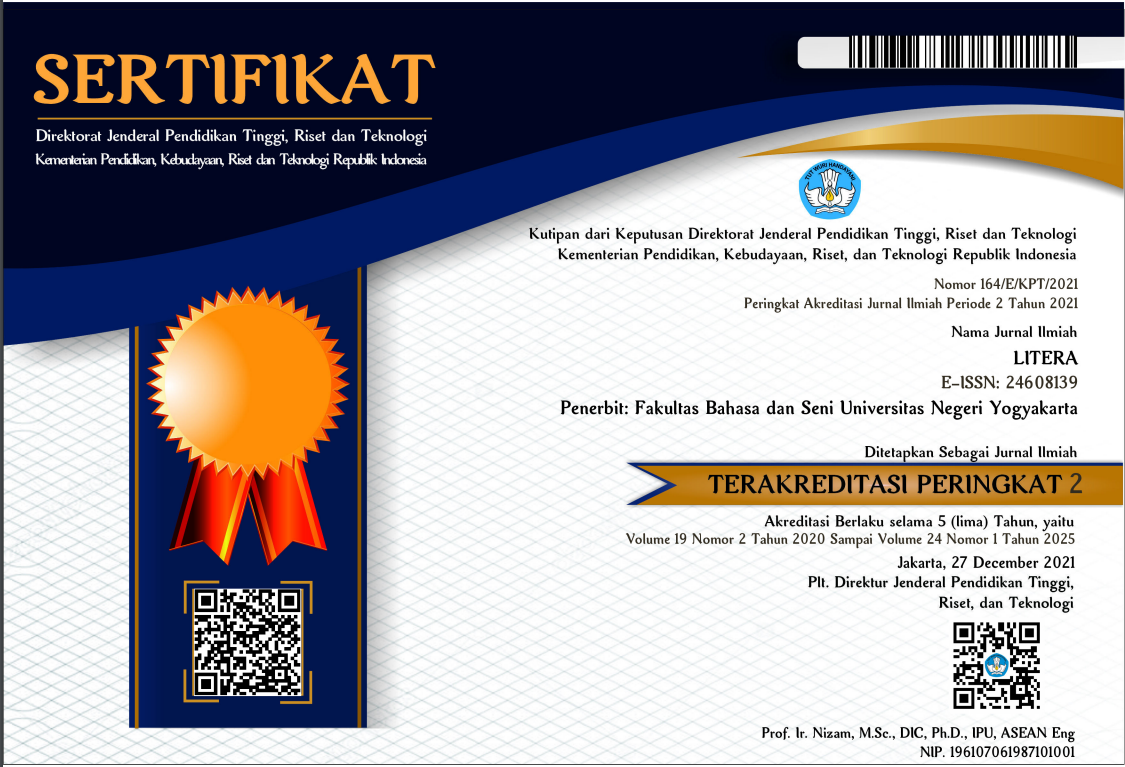PENGARUH BUKU CERITA BERGAMBAR TERHADAP KEMAMPUAN MEMBACA PEMAHAMAN DAN HASIL BELAJAR SISWA
Downloads
Penelitian ini bertujuan untuk mengetahui: (1) pengaruh penggunaan media buku cerita bergambar terhadap kemampuan membaca pemahaman siswa kelas IV sekolah dasar, (2) pengaruh penggunaan media buku cerita bergambar terhadap hasil belajar siswa kelas IV sekolah dasar, dan (3) pengaruh penggunaan media buku cerita bergambar terhadap kemampuan membaca pemahaman dan hasil belajar siswa kelas IV.
Penelitian ini merupakan penelitian kuasi eksperimen dengan desain Pretest-Posttest Non-Equivalent Control Group Design. Populasi dalam penelitian ini adalah siswa kelas IV SD N se-Kecamatan Prambanan Sleman, Yogyakarta yang telah menerapkan Kurikulum 2013. Sampel penelitian adalah 84 siswa SD Negeri Delegan 2, SD Negeri Delegan 3, dan SD Negeri Dadapsari. Sampel penelitian dibagi menjadi kelas eksperimen dan kelas kontrol dengan teknik cluster random sampling. Kelas eksperimen menggunakan buku cerita bergambar dan kelas kontrol menggunakan buku kurikulum 2013. Kelas eksperimen berjumlah 56 siswa dan kelas kontrol berjumlah 28 siswa. Instrumen yang digunakan untuk mengukur kemampuan membaca pemahaman dan hasil belajar siswa adalah lembar kuisoner tes tertulis. Teknik analisis menggunakan uji Paired Sample t-Test dengan taraf signifikansi 0,05
Hasil penelitian menunjukkan bahwa: (1) buku cerita bergambar berpengaruh terhadap kemampuan membaca pemahaman siswa dengan hasil nilai Sig (2-tailed) pada kelas eksperimen diperoleh nilai t hitung (9,346) > t tabel (2,05) dan, (2) buku cerita bergmbar berpengaruh terhadap hasil belajar, dengan uji t menunjukkan nilai t hitung (13,914) > t tabel (2,05). Simpulan yang dihasilkan adalah bahwa buku cerita bergambar berpengaruh terhadap kemampuan membaca pemahaman dan hasil belajar siswa kelas IV sekolah dasar. Hasil uji efektifitas diketahui persentase peningkatan pada kelas eksperimen mempunyai peningkatkan lebih baik dibandingkan kelas kontrol.
Kata Kunci : buku cerita bergambar, kemampuan membaca pemahaman, hasil belajar
Downloads
Aybala, C. (2017). Primary School Pre-Service Teachers Self-Assessed Competency Level of Teaching How to Read in Turkey.Educational Research and Reviews, 12(17), 855–859. https://doi.org/10.5897/ERR2017.3325.
Campbell, K H. (2007). Less is more: teaching literature with short texts grade 6-
Portland-Maine: Stenhouse Publishers.
Dennis, L., et all. (2013). Authentic Assessment: Establishing a Clear Foundation for Instructional Practices. Preventing School Failure, (7)4, 189-195.
https://doi.org/10.1080/1045988X.2012.681715.
Dittman, C. K. (2016). The Impact of Early Classroom Inattention on Phonological Processing and Word-Reading Development.Journal of Attention Disorders, 20(8), 653-664.
Duke, N. K, & Pearson, P. D. (2017). Effective practices for developing reading
comprehension. Journal of Education, 189(1-2_, 107-122 doi.org/10.1177/0022057409189001-208.
Dyer, J., Gregersen, H., & Christensen, C.M. (2011). The innovator's DNA mastering the five skills of disruptive innovators. Boston: Harvard Business Review Press.
Goldston, M.J. & Downey, J. (2013). Your sciences classroom: becoming an elementary/middle school secience teacher. Los Angeles: Sage Publications, Inc.
Gonen, M. & Guler, T. (2011). The environment and its place in children's picture story books. Procedia – Social and Behavioral Sciences, 15, 3633. https://doi.org/10.1016/j.sbspro.2011.04.347.
Hairrell, A., Rupley, W. H., Edmonds, M., Larsen, R., Simmons, D., Willson, V., Vaughn, S. (2011). Examining the impact of teacher quality on fourth-grade students' comprehension and content-area achievement. Reading & Writing Quarterly, 27, 239 - 260. http://dx.doi.org/10.1080/10573569.2011.560486.
Kementerian Pendidikan dan Kebudayaan. (2014). Peraturan Menteri Pendidikan dan Kebudayaan Nomor 57, Tahun 2014, tentang Kurikulum 2013 Sekolah Dasar/Madrasah Ibtidaiyah.
Keshavarz, M. (2011). Measuring course learning outsomes. Jurnal of Learning Design. 4, 1-9.
Kotaman, H., & Balci, A. (2016). Impact of storybook type on kindergarteners' storybook comprehension. Early Child Development and Care, http://dx.doi.org/10.1080/03004430.2016.1188297.
Libresco, A. S. (2012). Every book is social studies book: how to meet standards
with picture books, K-6. California: Libraries Unlimited.
Loh, E. K. Y. (2016). Picture storybooks in teaching chinese as a second
language. Comparative Literature and Culture, 18(2). Retrieved from
http://docs.lib.purdue.edu/clcweb/vol18/iss2/.
Lund, J. (2013). Authentic assessment: its development & applications. Journal of Physical Education, Recreation & Dance, 68 (7), 24-40. https://doi.org/10.1080/07303084.1997.10604979.
Lynch-Brown, Carol M. & Carl M. Tomlinson. (2008). Essentials of Children's Literature. Boston: Pearson Education.
Mantei, J. & Kervin, L. (2014). Interpreting the images in a picture book: students make connections to themselves, their lives and experience. English Teaching: Practice and Critique. Vol. 13, No. 2 pp. 76-92. http://education.waikato.ac.nz/research/files/etpc/files/2014v13n2art5.pdf.
Masruro, Lailatul. (2018) Penggunaan buku cerita bergambar terhadap hasil belajar siswa pada materi IPS kelas III SD YPI Darussalam Cerme Gresik. Jurnal Pendidikan Guru Sekolah Dasar. 6 (2). 198-208.
Nejabati, N. (2015). The effect of teaching self regulated learning strategies on EFL student's reading comprehension. Journal of Language Teaching and Reasearch,6(6),1343 1348.doi:http://dx.doi.org/10.17507/jltr.060623.
Ongowo, R.O. & Indoshi, F.C. (2013). Science process skills in the Kenya certificate of secondary education biology practical examinations. Scientific Research, 4(11), 713-717. https://doi: 10.4236/ce.2013.411101.
Roslina. (2017). The effect of picture story books on students' reading. Advances in Language and Literary Studies, 8(2), 213-221. http://dx.doi.org/10.7575/aiac.alls.v.8n. 2p. 213.
Saccardi, M. (2014). Creativity and Children's Literature. Santa Barbara:
ABC-CLIO.
Santrock, J. W. (2012). Life-span development perkembangan masa-hidup edisi
ketigabelas jilid i. Jakarta: Erlangga. (Edisi asli diterbitkan tahun 2011
oleh Mc Graw Hill Companies Inc. 1221 Avenue of American, New
York).
Settlage, J. & Southerland, S. A. (2012). Teaching science to every child: using culture as a starting point. New York: Routledge.
Taniredja, T., Faridli, E. M., & Harmianto, S. (2015). Model-model Pembelajaran
Inovatif dan Efektif. Bandung:Alfabeta.
Verhoeven, L., Reitsma, P., & Siegel, L. S. (2011). Cognitive and Linguistic Factors in Reading Acquisition. Reading and Writing, 24(4), 387–394. https://doi.org/10.1007/s11145-010-9232-4.
Wahyuningsih, A., & Kiswaga, G. (2019). The effectiveness of CIRC learning
model and PQ4R learning model on reading comprehension skills of
elementary school students. Jurnal Prima Edukasia, 7(1), 82-93. doi:https://doi.org/10.21831/jpe.v7i1.9701.
Zuchdi, D. (2008) Strategi Meningkatkan Kemampuan Membaca. Yogyakarta: GMU Press.
























